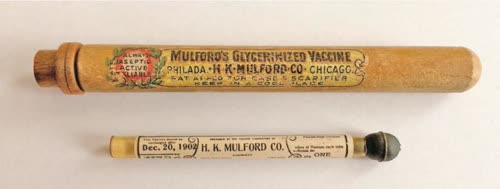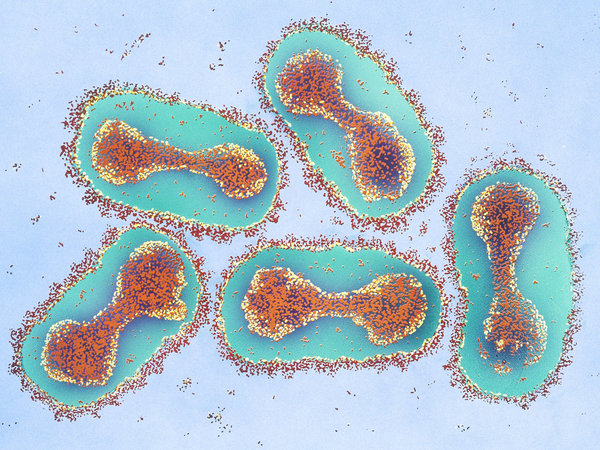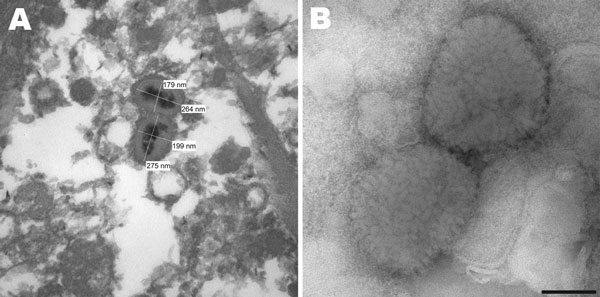|
‘Bioterrorism more likely than a pandemic,’ Gates warns "A bioterrorist attack that could wipe out 30 million people in less than a year is becoming increasingly likely because it is easier than ever to create and spread deadly pathogens, Microsoft founder Bill Gates warned during an interview with the United Kingdom’s Telegraph newspaper. In fact, an act of bioterrorism is more likely than a pandemic, he warned, and a lethal respiratory pathogen such as a recreated smallpox virus could be more dangerous than a nuclear attack. Gates, whose charitable foundation funds research into quickly spotting outbreaks, said it was more important than ever to help foreign countries monitor diseases to prevent a global tragedy." |
|
How recreating horsepox in a lab could lead to cancer cures You just call up a company and say I need some DNA?
|
|
Why there's finally a drug for smallpox even though the disease no longer exists Fortunately, it doesn't exist anymore. After a global vaccination campaign, smallpox was declared eradicated in 1980.
|
|
It’s Getting Too Easy to Create Dangerous Viruses It took David Evans’ team of scientists at the University of Alberta in Edmonton, Canada, about six months and $100,000 to recreate the horsepox virus, a close relative of the smallpox virus that killed perhaps 300 million people in the 20th century before it was eradicated in 1980. In a summary of the research, the World Health Advisory Committee on Variola Virus Research wrote that “recreation of such viral genomes did not require exceptional biochemical knowledge or skills, significant funds, or significant time.” |
|
DIY horsepox created from mail-order DNA prompts search for new gene editing rules at U of A An extinct horsepox virus — cousin of the deadly smallpox virus — has now been stitched together by University of Alberta researchers and now law professors at the school are drafting a policy to regulate gene editing research.
|
|
VACCINIA VIRUS DNA POLYMERASE AND RIBONUCLEOTIDE REDUCTASE: THEIR ROLE IN REPLICATION, RECOMBINATION AND DRUG RESISTANCE Examining Committee |
|
ROADMAP FOR IMPEMENTING BIOSECURITY AND BIODEFENSE POLICY IN THE UNITED STATES The key findings and conclusions from this case study are: |
|
The Evolutionary Biology of Poxviruses The poxviruses (family Poxviridae) are a family of double-stranded viruses including several species that infect humans and their domestic animals, most notably Variola virus (VARV), the causative agent of smallpox. The evolutionary biology of these viruses poses numerous questions, for which we have only partial answers at present. Here we review evidence regarding the origin of poxviruses, the frequency of host transfer in poxvirus history, horizontal transfer of host genes to poxviruses, and the population processes accounting for patterns of nucleotide sequence polymorphism.
|
|
Wikipedia "This article contains content that is written like an advertisement. Please help improve it by removing promotional content and inappropriate external links, and by adding encyclopedic content written from a neutral point of view." (July 2018) |
|
Construction of an infectious horsepox virus vaccine from chemically synthesized DNA fragments Edward Jenner and his contemporaries believed that his variolae vaccinae originated in horses and molecular analyses show that modern vaccinia virus (VACV) strains share common ancestry with horsepox virus (HPXV). Given concerns relating to the toxicity of modern VACV vaccines, we asked whether an HPXV-based vaccine might provide a superior alternative. Since HPXV may be extinct and the only specimen of HPXV that has been identified is unavailable for investigation, we explored whether HPXV could be obtained by large-scale gene synthesis. Ten large (10–30 kb) fragments of DNA were synthesized based on the HPXV sequence along with two 157 nt VACV terminal sequences, and were recombined into a live synthetic chimeric HPXV (scHPXV) in cells infected with Shope fibroma virus (SFV). Sequencing of the 212 kbp scHPXV confirmed it encoded a faithful copy of the input DNA. We believe this is the first complete synthesis of a poxvirus using synthetic biology approaches. This scHPXV produced smaller plaques, produced less extracellular virus and exhibited less virulence in mice than VACV, but still provided vaccine protection against a lethal VACV challenge. Collectively, these findings support further development of scHPXV as a novel replication-proficient smallpox vaccine. |
|
Construction of an infectious horsepox virus vaccine from chemically synthesized DNA fragments US National Library of Medicine |
|
The puzzling origin of the smallpox vaccine "However, in synthesizing the horsepox virus, the group led by virologist David Evans of the University of Alberta in Edmonton, Canada has also recreated the eradicated smallpox virus – a scandalous reason for which Evans’ research has been denied and unpublished. The World Health Organization has forbidden for the full smallpox genome to be reconstructed or to breed live smallpox virus in the lab." |
|
Canadian synthesizes a better smallpox vaccine — just in case terrorists bring the disease back Made from synthesized horsepox, it's believed to be a virtual clone of the original 1796 smallpox vaccine which developed hazardous side effects over time. |
|
Did Pox Virus Research Put Potential Profits Ahead of Public Safety? "using the natural virus might have prevented the pharmaceutical company he is working with from commercializing horsepox as a new vaccine" |
|
Tonix Pharmaceuticals Announces Demonstrated Vaccine Activity in First-Ever Synthesized Chimeric Horsepox Virus NEW YORK, March 02, 2017 (GLOBE NEWSWIRE) -- Tonix Pharmaceuticals Holding Corp. (Nasdaq:TNXP) (Tonix), a company that is developing innovative pharmaceutical products to address public health challenges, working with researchers from the University of Alberta, a leading Canadian research university, today announced the successful synthesis of a potential smallpox-preventing vaccine. This vaccine candidate, TNX-801, is a live form of horsepox virus (HPXV) that has been demonstrated to have protective vaccine activity in mice. |
|
Successful Development of TNX-801 May Lead to an Improved Smallpox-Preventing Vaccine NEW YORK, Jan. 19, 2018 (GLOBE NEWSWIRE) -- Tonix Pharmaceuticals Holding Corp. (Nasdaq:TNXP) (Tonix), a company developing innovative pharmaceutical and biological products to address major public health challenges, today announced the publication of research describing the successful synthesis and characterization of a potential smallpox-preventing vaccine based on horsepox virus. The research was conducted in conjunction with scientists from the University of Alberta, a leading Canadian research university. |
|
How Canadian researchers reconstituted an extinct poxvirus for $100,000 using mail-order DNA "A group led by virologist David Evans of the University of Alberta in Edmonton, Canada, says it has synthesized the horsepox virus, a relative of smallpox, from genetic pieces ordered in the mail. Horsepox is not known to harm humans—and like smallpox, researchers believe it no longer exists in nature; nor is it seen as a major agricultural threat. But the technique Evans used could be used to recreate smallpox, a horrific disease that was declared eradicated in 1980. "No question. If it’s possible with horsepox, it’s possible with smallpox,” says virologist Gerd Sutter of Ludwig Maximilians University in Munich, Germany." |
|
Tonix Pharmaceuticals Announces Publication Reporting Synthesis, Construction and Characterization of a Potential Smallpox-Preventing Vaccine Candidate TNX-801 (Live Horsepox Virus from Cell Culture) NEW YORK, Jan. 19, 2018 (GLOBE NEWSWIRE) -- Tonix Pharmaceuticals Holding Corp. (Nasdaq: TNXP) (Tonix), a company developing innovative pharmaceutical and biological products to address major public health challenges, today announced the publication of research describing the successful synthesis and characterization of a potential smallpox-preventing vaccine based on horsepox virus. The research was conducted in conjunction with scientists from the University of Alberta, a leading Canadian research university. |
|
Poxviridae Poxviridae is a family of viruses. Humans, vertebrates, and arthropods serve as natural hosts. There are currently 69 species in this family, divided among 28 genera, which are divided into two subfamilies. Diseases associated with this family include smallpox.[1][2] |
|
A Controversial Virus Study Reveals a Critical Flaw in How Science Is Done After researchers resurrected a long-dead pox, some critics argue that it's too easy for scientists to make decisions of global consequence.
|



